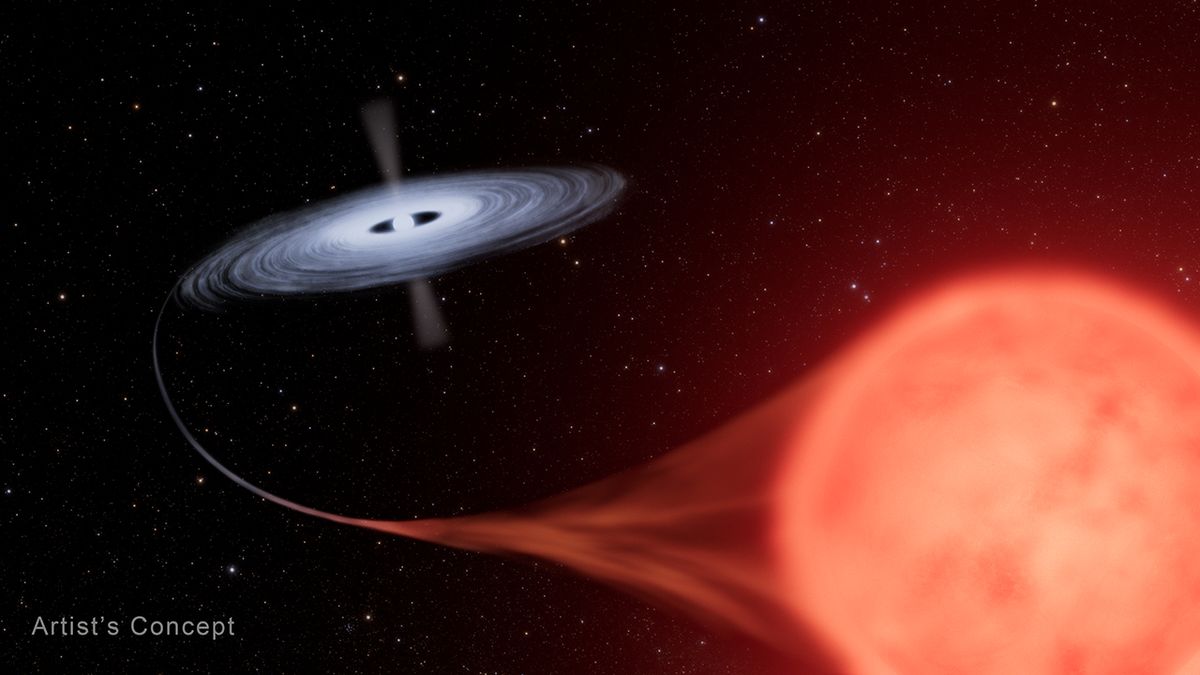The aftermath of a thermonuclear explosion in a binary star system about 3,400 light years away has been witnessed by the Hubble Space Telescope.
HM Sagittae, or HM Sge for short, is what’s known as a symbiotic system, in which a white dwarf is feeding off a companion red giant star. The stolen material forms an accretion disk swirling around the white dwarf. If too much material falls from the disk onto the white dwarf at once, the pressure and temperature becomes so great that a thermonuclear explosion detonates on the surface of the white dwarf.
Though this explosion isn’t enough to destroy the white dwarf in a supernova, it does release enough energy to cause the system to brighten in what’s termed a “nova.”
Between April and September 1975, HM Sge went nova in the constellation of Sagitta, the Arrow. It brightened in the night sky by six magnitudes from magnitude +17 (visible only to telescopes with apertures larger than about 305mm/12 inches) to magnitude +10.5, at which point it became more easily visible to telescopes with smaller apertures equal to about 102mm/4 inches, allowing amateur astronomers to keep track of it. This brightening equates to an increase in luminosity of 250 times.
Related: ‘Vampire’ neutron star blasts are related to jets traveling at near-light speeds
Ever since it went nova, HM Sge hasn’t been following the rules. Most novas simmer down after a few days; HM Sge remained at its peak brightness for years, until the mid-1980s, before it began to slowly fade, punctuated by more notable dimming events. Even now, it has only faded to about magnitude +12.
“In 1975 HM Sge went from being a nondescript star to something all astronomers in the field were looking at, and at some point the flurry of activity slowed down,” said Ravi Sankrit of the Space Telescope Science Institute (STScI) in a statement.
“Symbiotic stars like HM Sge are rare in our galaxy, and witnessing a nova-like explosion is even rarer,” added Steven Goldman, also of STScI, in the statement. “This unique event is a treasure for astrophysicists spanning decades.”
Observations over the years with a multitude of telescopes have tried to get to the bottom of what is happening in HM Sge. Now, Goldman and Sankrit have attained new results with their team, based on 2021 Hubble Space Telescope observations and data collected with NASA‘s now-defunct SOFIA (Stratospheric Observatory for Infrared Astronomy), which featured an infrared telescope in the back of a Boeing 747 aircraft, in 2021 and 2022.
The onset of dimming with regard to the system in 1985 until now has been attributed at least partly to the behavior of the red giant star. It’s what’s called a Mira variable (after the prototype of the class, Mira — omicron Ceti — in the constellation of Cetus, the Whale) and endures periodic pulsations roughly every 534 days. The start of the system’s dimming in the mid-1980s has been attributed to one of two things. It could either have been instigated by a larger-than-typical mass-loss event from the red giant linked to its pulsations, which would have created an outpouring of dust that blocks some of the light, or it could be the result of the 90-year, non-circular orbit of the white dwarf and red giant about one another taking them farther apart, reducing the amount of material flowing between the two. Currently, the separation between the two components of the system is approximately 40 astronomical units (AU), where 1 AU is defined by the average distance between Earth and our sun, 149.6 million kilometers (93 million miles). For comparison, Neptune is 30 AU from the sun.
Hubble’s observations also revealed a strong emission line from ionized magnesium. This emission line was not present in spectra of HM Sge dating back to 1990, when the temperature of the white dwarf was 200,000 degrees Celsius ( about 400,000 degrees Fahrenheit). For strongly ionized magnesium to exist in large abundance, the temperature of the white dwarf must have risen in that time to 250,000 degrees Celsius (about 450,000 degrees Fahrenheit). This makes it one of the hottest white dwarfs known, despite the system fading in brightness overall. What is causing this rise in temperature is currently a mystery.
Furthermore, SOFIA was able to detect emission lines from water vapor in the disk for the first time in a symbiotic binary, and use its signal as a proxy for measuring the properties of the accretion disk. The water molecules appear to be moving at 29 kilometers (18 miles) per second, which is attributed to their speed flowing around the edge of the disk.
However, most of the emission lines in HM Sge’s spectrum are weakening compared to 1990, showing that the system is slowly changing and evolving, possibly as the red giant and white dwarf move apart.
Goldman and Sankrit’s team conclude that the HM Sge system settled down to a “new normal” quite quickly after the nova explosion 1975 with only a slow decrease in brightness on average over the years (there has been some up and down in brightness, both in optical and the infrared and not always at the same time, again attributed to the behavior of the red giant). The overall fading may continue at its slow pace for many more years, until the white dwarf and red giant come close again in their orbit, increasing the amount of material flowing between the two of them and sparking another nova.
Finally, the white dwarf is a preview of what fate has in store for the red giant companion. Both were once sun-like stars in a binary system, one star a little more massive than the other. The more massive star used up its nuclear fuel faster, and evolved into a red giant that eventually cast away its diffuse outer envelope to reveal its exposed, inert core — the white dwarf. The other star evolved a little more slowly, but is now following the same path as its sibling, first evolving into a red giant and then into a white dwarf after a million or so years.
The gravitational upheaval that the red giant’s transformation will cause could draw the two white dwarfs close to one another. One day, if they collide, they will explode as a Type Ia supernova, but that won’t happen for hundreds of millions, or perhaps even billions, of years.
The findings from Hubble and SOFIA were published in The Astrophysical Journal.











/https://tf-cmsv2-smithsonianmag-media.s3.amazonaws.com/filer_public/34/31/3431771d-41e2-4f97-aed2-c5f1df5295da/gettyimages-1441066266_web.jpg)








Discussion about this post